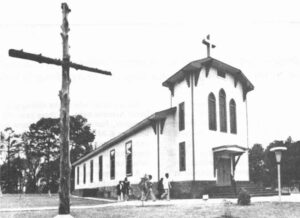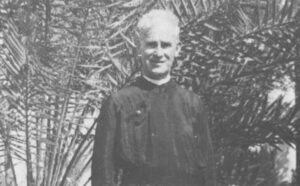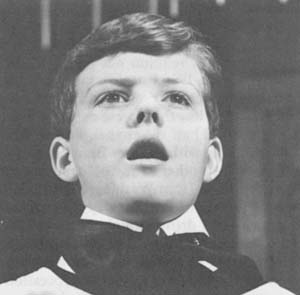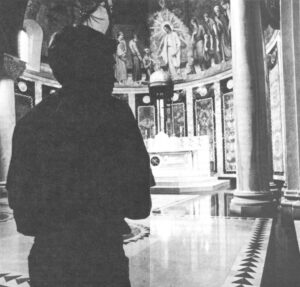DULUTH, Minn.–Getting in. Grammar schools were the seminary farm team in the Fifties, and sisters were the unpaid scouts. In a way getting into a seminary after eighth grade was like riding a river-all you had to do was go with the current. Usually this stream emptied out inside brick fortresses in burgs far removed from the world, the flesh, and the devil. You got nudged onto the flow in various ways, some of them not terribly subtle. “Getting married is fine, but it’s a diamond in your cap to be a priest,” I remember a nun confiding one day in the cloak room. It made a certain sense. It was an elitist theology but I had no sense of that. This theology, that priesthood and sisterhood are first, marriage is second, and the lay state comes in a lagging, suspect third, had been promulgated more or less officially in the Church for generations: my nuns were merely passing it along. The ladder would not get restocked until after Vatican II, and then would come, at least for a time, a plummet of the celibate life, a wholesale devaluation. Flex and reflex.
He was a class ahead of me, and we were in the seminary together only one year before he left, and what I mostly remember is a short, tough, self-assured kid with a blond flattop and slightly hoarse voice and extraordinarily fine teeth that could make his grin come on like a 100-watt bulb. But the name Pat Power has had resonance in me for nearly 20 years, and that is because he died young, at just eighteen. It seemed to me then as though a sword, deadly and blinding, had come from its scabbard to snatch him, and the inexplicability of this only made the ways of God more absorbing. I remember the night the note went up on the board outside of chapel, just before retiring prayers, informing us that Pat Power had died in an automobile crash somewhere in the Midwest. He had been gone two years then. I studied that note, scuffing my shoe on a smooth terrazzo floor. I wondered: if he had persevered would he be alive now? It was a thought for my own life. Something to take to bed, to rub like worry beads…
Friday, October 13, 1961. That morning Ike took Mamie for a ride in Gettysburg with his new driver’s license. In Dallas Harry Truman visited Sam Rayburn in Baylor Hospital. And in Winona, Minnesota, where he had just begun his freshman year of college, eighteen-year-old Patrick Power packed a light bag and headed for his last classes of the week. Though usually bouyant he seemed especially so today: he was going home to Duluth for the weekend. Tonight he would escort his girl, Carol Lutz, to a prom at St. Scholastica’s High. Power had begun dating Lutz a year or so earlier, when he was finishing high school, after he had dropped out of a school for the priesthood in a place called Holy Trinity, Alabama. Two of his best friends from Duluth, Larry Gaida and Danny Grandmaison, were driving down to Winona today to pick him up. They were coming in a new Corvair Monza with 700 miles on it.
Just before heading across campus to class, Power, on impulse, decides to invite a newfound friend from college to come home with him. The friend’s name is George Harrington, and since he has nothing better to do for the weekend, he accepts the invitation. Later, in the welter of confusion following the crash, Harrington will disappear. But that is only one of the lesser mysteries, and, besides, gets ahead of things.
First, some biography: Patrick Power grows up on East Superior in Duluth, in sight of the blue inland prairie for which his street is named. Sometimes, riding his bike along the shore of the great lake on his way to St. Michael’s parish, he spies freighters coming in. They seem small as tugboats in a bathtub. Someday he’ll ride a freighter to his own adventure, he tells himself. At St. Michael’s, Pat helps Father Perkovich, the assistant pastor, collect old things out of people’s basements for the Used-A-Bit Shop. Father Perkovich has a truck, and on weekends he and Pat and Danny Grandmaison and some of the other altar boys go around the parish scavenging. Pat and Danny are best friends. Pat lives at 40th and Superior, Danny at 59th and Superior. One day in their eighth grade year Pat tells Danny he is thinking of going away the next fall to a prep seminary in Alabama. Danny is not totally surprised but wonders why his friend should want to go so far.
St. Joseph’s Prep Seminary Yearbook-Holy Trinity, Alabama.

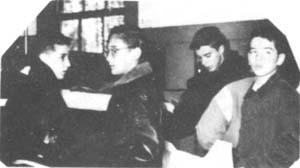
G. Mischier, R. Rink, B. Bailey and G. Motherway, “Did he say locker inspection?”

A. Pineault, M. Lebeschak and T. Michaels, “Duce in the side pocket.”

A. Pineault, H. Stryker and E. Eber, “The round peg goes in the round hole, right?”
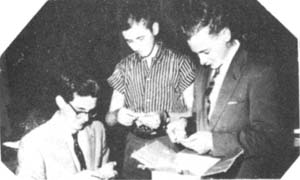
E. Pass, J. Mischler and M. Lebeschak, “The mail must come through.”

R. Brown and T. Michaels, explain signification of vestments on Vocation Day.
It seems insane now but in many ways it was a child-centered religion, a kiddie ministry. Four centuries after the Council of Trent, an overriding idea stuck fast: get a vocation young, pick it ripe, “before the habits of vice take possession of the whole man.” Those are words from Trent, 1563, when seminaries formally began. After Vatican 11 that idea would collapse like a mud slide. But while it prevailed nothing seemed stronger. The system was kept in operation not only by nuns and the parish priest and in some cases parents, but by waves of handsome, young, articulate pitchmen for the religious orders who would ride from elementary school to elementary school with movies and rubberbanded stacks of brochures and detachable mail-in cards in the trunks of their solid colored, chromeless sedans-holy Professor Harold Hills, drumming through Iowa or Illinois or Minnesota for a boy’s seminary band. The only priest from my class remembers it like this: “I was in sixth grade. I helped father Adrian pack up the projector. I carried it out to his car and just stood there. I wanted him to take me with him right then.” These charismatic young priests, often fresh from the altar of their ordination, could seem like a Davy Crockett and Huckleberry Finn and St. Francis rolled in one, not to say a Lone Ranger, who was probably a bigger patron saint of Fifties vocations than all of the saints and the stained glass windows of the Vatican combined. The Lone Ranger myth, in fact, was the subliminal vocation pitch: give the full high-riding adventure of yourself in the mission fields of China or New Zealand or deepest Mississippi, where your territory will cover six Bible thumping counties and 4,265 square miles. Dare to be great. Come on the river.
So it seemed nothing for the eighth grade class of St. Polycarp, or Mary, Star of the Sea, or St. Rose of Lima to be sending off a dozen boys to the seminary in the fall. Some of these chosen would be going only as far as the diocesan day-hop seminary, while others, like me and Pat Power, would be going to a distant state, adventuring there by rail with other similarly inspired boys (“A whole car reserved for the gang going down from Chicago!”), each of us with a small blue and white decal in the shape of a pennant gummed on our spanking-new Samsonite suitcase. On the pennant was this: St. Joseph’s Prep Seminary, Holy Trinity, Alabama. If there were psychological implications to some of these escapes from home, these fluid rides down the river, they were seldom raised. That candle was still mostly kept under a bushel. The following June, now fifteen, we would come home from our first year “abroad” with a certain status, if awkwardness and dislocation. We were spiritual mariners on shore leave, the parish’s little priests, levites in progress. We were also forbidden fruit, eyed invidiously by the town girls.
October 13, 1961. The death car is gliding through lush Wisconsin farmland. it is an unusually bright and crisp day, and the sun seems almost pasted in a turquoise sky. Larry Gaida, who is driving, pulls the Corvair off to the side of the road. All four occupants get out to take a leak. (Later, trying to reconstruct the accident, the trooper will ask if there had been drinking going on; there wasn’t.) Climbing back in, Pat Power, who has been riding up front, suddenly hops in the back seat on the right side. There is no apparent reason for this switch of seats and at the time the change seems meaningless. Danny Grandmaison, who up to now has been riding in the back with Pat’s friend from college, George Harrington, shrugs, takes the front seat opposite the driver. Just before he climbs in Grandmaison happens to glance at his watch. It is 3:12 p.m., exactly eighteen minutes before the crash.
Further biography: Power’s folks are photographers and run a studio in downtown Duluth, four doors from the Hotel Duluth. The Powers have two older daughters, but Pat is their only boy. Avon is their daughter closer in age to Pat. After her brother’s death she will name one of her own sons for Pat, and twenty years from the crash Avon will still have a holy card in her purse commemorating the day of her brother’s burial.
At Holy Trinity, Alabama, in the school year 1957-’58, Pat Power joins the Photography Club, subs on the freshman basketball team, plays for the Man-O-War, which wins the junior intramural volleyball championship. There are thirty-six seminarians in the freshman class at Holy Trinity, and Power cannot truthfully be said to be among either the group’s intellectual or athletic or spiritual elite. He is nearly the shortest member of his class (Tom Langlois is perhaps half an inch shorter) but despite this there seems a certainty and self-possession about him. He seems almost a center point to his class, an equilibrium point. In the class’ freshman portrait for the yearbook, taken in early spring on the chapel steps, Power stands in the precise middle of the picture in the front row. The incandescent smile is in place, and he seems almost at attention, as if he is in military school instead of a seminary. He looks as if he knows exactly what he is about.
October 13, 1961. The death car is on Highway 10 outside a little Wisconsin town named Durand. There is a turn to the right, and Larry Gaida misses it. No big deal. He goes on past the Y in the road for several hundred yards, wheels the Corvair 360 degrees into a brittle glare. Gaida starts back down the road. What happens next is not precisely clear, so viciously and suddenly does it occur. Danny Grandmaison, daydreaming, sees Larry’s foot suddenly slam for the brake. Danny looks up. A green hood is coming into the windshield.
Gaida, the driver, survives with broken bones and multiple contusions. Grandmaison, sitting opposite him, survives with five or six broken teeth and hugh gashes in his face: he has hit the dashboard. Though he will carry scars for the rest of his life, his injuries are such that the doctors decide he doesn’t require plastic surgery, they can sand. Later, lying in his hospital bed-he will be confined nearly a month–Grandmaison will watch the leaves fall outside his window and become depressed, unable to eat. Still later, coming home from the hospital in the back of a new Caddy, he will be unable to keep himself from shifting to the other side of the car every time there is oncoming traffic. At home he will go out to his garage every day for two weeks and sit behind the wheel of his ’57 Chevy. He will put the key in the ignition and just sit there. Eventually he will be able to turn the key.
George Harrington, sitting in the back seat, behind the driver, escapes with almost no injuries. But Pat Power is critically hurt. Mrs. Harry Stewart, one of three passengers in the other car, will also die from her injuries. Though he lingers for 24 hours, it is almost certain Power never knows what has hit him. What has hit him is the windshield. He is hurled from the back seat into the glass, and the blow snaps his neck, tears open his head. He has suffered a compound fracture of the cerebral cortex.
In 1957, the year Pat Power left Minnesota for Alabama, there were 36 million Catholics in America; other estimates had the number as high as 50 million. It was a remarkable rise. When the nation began there had been just 40 thousand Catholics in a population of four million, and the most important fact about these 40 thousand, as historians have pointed out, was that they were not Protestant. “Most awful and affecting: the poor wretches, fingering their beads, chanting Latin … their Paternosters and Ave Marias,” John Adams wrote to his wife Abigail in 1774. For a time in the new land there had been penal laws against Catholics. By the middle of the next century the numbers, if not attitudes, had begun to even out some. The Irish were arriving in masses, others were not far behind. (Between 1900 and 1910 alone, 2,300,000 Italians, most of them Catholic, came.) And by the time Pat Power swam to awareness in Duluth, Minnesota in the middle 1950’s, pollsters were already compiling data that showed, economically and socially, Catholics were about to draw even with the rest of the country, and the dramatic signal of this collective arrival would come a few years hence when America would be willing to elect to the Presidency a young and disproportionately handsome United States Senator from Massachusetts who was also a Catholic-a kind of secular priest, it almost seemed, a minister of brains and political power.
Seminaries seemed everywhere in the landscape. In 1930 there had been just 187 priest schools in America, but now they were rising faster almost than the Church could keep count. By 1958, the year I left for Alabama, a year behind Pat Power, there were 381 separately organized Catholic seminaries, a full third of them having started up since the Second World War. This proliferation was doubtless answering the baby boom and Catholic rise to the middle class and a post-war premium on higher education, but also, I suspect, the significant religious response that sometimes comes after a people bumps its head against a stone wall of limits: war had afforded hints of beyond, something otherly. What works on an individual can also work corporately. Supply was meeting demand. It almost seemed a syllogism: Christian family life is strong; it is a non-combative age; therefore why shouldn’t young men naturally be responding to the devote life? The wider world of the 1950’s had the Beats and Korea but the contented ghetto Pat Power and I and other boys like us were in had the final, ripe flex of an old Catholic muscle; if you have talents you should give them back to God in the form of religious life. After the Fifties the word “vocation” would mean more than seminary or convent. A report released by the National Catholic Educational Association at the end of 1958 would unprophetically conclude: “The seminary movement in the United States is in its infancy.”
Final biography: Back home in Duluth for his freshman high school summer, 1958 seminarian Pat Power buys an old Merc off a friend named Jimmy Sage. The car is still in primer color but Power is proud to have it. He is fifteen years old and he has wheels. One night not long after he has the car, out with some pals, he meets a girl named Susie. In a few weeks he is, according to a friend, parking with her down at Brighten Beach, a kind of lover’s lane. At the end of August Pat tells Susie goodbye and returns to the seminary. He doesn’t tell any of his seminary classmates about Susie, and the following June, his sophomore year, he shakes hands and tells his friends he will see them in September. One of his classmates jokingly writes this in the back of Power’s yearbook: “Don’t abuse your vacation, and you won’t lose your vocation.” In September Pat Power is missing: he has dropped out of the seminary.
He finishes high school at Cathedral in Duluth, then enrolls at St. Mary’s College, Winona. Winona is a small town on the Wisconsin border, and St. Mary’s is a small Catholic institution run by the Christian Brothers. Actually Pat is unsure about going to college, but his parents nudge. He begins St. Mary’s in the fall of 1961. Shortly after he enrolls he comes home to Duluth for a wedding. On Sunday, before heading back, he tells his mother, “I have a funny feeling right here.” He says this and lightly pounds his breast. Several nights later Josephine Powers has a dream, and in the dream her son tells her, “I’m never going back to that school.” Later, after the burial, Mrs. Power will learn that shortly before her son died he had written a paper for one of his teachers in which he hinted he would die young. The teacher will send her the paper in the mail.
October 13, 1961. Highway 10 is a blur of wreckage and flashing lights. One ambulance speeds Pat Power to a regional hospital in Eau Claire, Wisconsin. The doctors there determine he should go to the Mayo Clinic in Rochester. On the way to St. Mary’s Hospital in Rochester, an emergency tracheotomy is performed. Meanwhile Danny Grandmaison is in the emergency room at the Durand hospital and on the cold, narrow table he drifts to consciousness. Shapes float about him. Instinctively he begins aloud an act of contrition. Before he slips back to sleep he thinks he sees George Harrington standing a few feet away, studying him. He struggles to say something to Harrington. This is the last time anyone connected with the accident will remember seeing Harrington. Apparently Harrington is treated in the emergency room and released. What becomes of him afterward, where he goes, no one is sure. Perhaps the accident has so shaken him that he returns to his parents’ house in Chicago, but in any case he is not present at Pat’s funeral a few days hence. In fact, the Power family never sees him, never hears from him. Ever after George Harrington to them is just the fourth rider, a faceless name.
At the Power Photography Studio in downtown Duluth, Mr. and Mrs. Power are almost finished with the day’s work. Though it is Friday their week is not over: they have a full book of appointments tomorrow. James Power has felt under the weather all week and will be glad to get home for some rest tonight. He won’t see much of his son this evening-Pat will be at the dance with Carol at St.Scholastica’s-but there will be time for visiting with Pat tomorrow evening and on Sunday before he goes back to Winona.
No one can really explain this, but in the confusion of the crash and the rush to the various hospitals, the Power family is never notified of the accident. Grandmaison’s and Gaida’s folks are contacted almost immediately but somehow the Powers are overlooked. Coming home from work an in-law hears a bulletin on the radio, pulls his car over, phones his wife, who phones Mr. and Mrs. Power. It is dark now, and by the time the family gets more details of the accident Pat is already in hopeless surgery in Rochester. To complicate matters, there is almost no way of reaching all of the people who are due at the studio in the morning for portraits. (The Powers policy is to take names over the phones, not callback numbers: after the death this policy will be changed.)
At length it is decided Mrs. Power should go down to Rochester and Mr. Power should remain in Duluth. Carol Lutz’ parents drive Mrs. Powers down, and they arrive in the middle of the night. Mrs. Power is led into the acute care unit. Her son is so bloated and smashed she thinks it is not him. Finally she recognizes a small scar on his forehead he has had since he was a child. The doctors inform her the prognosis is zero. Once an hour, through the rest of the night and into the next day, she goes in and sits by her son’s bed. Sometime in the middle of the next day Mrs. Power tells the doctor she is going home. At five o’clock that afternoon, Saturday, October 14, 1961, coming over High Bridge into Duluth, the Lutzes and Mrs. Power hear on the car radio that Pat Power is dead. On Sunday the Duluth News Tribune gives the death four paragraphs on page one. Among other things is a mention that the deceased once studied at a seminary in Alabama. The funeral mass is at nine o’clock Wednesday morning, burial afterward in Calvary Cemetery.
Five voices:
Avon Power Wrazidlow, sister of Pat Power: “There were no absolutes, even now everything seems fuzzy.”
Reverend Frank Perkovich, pastor of Resurrection Parish, Evelth, Minnesota: “He passed through here. God decided to take him and that was it. Don’t ask me why.”
Josephine Power, mother of Pat Power: “Funny, he was supposed to pick up his first paycheck that afternoon from a parttime photography job he’d begun in Winona. But he couldn’t wait. He wanted to get on the road right then.”
Registrar at St. Mary’s College, Winona, Minnesota: “George Harrington didn’t finish here. We’ve officially got him listed ‘unknown’. Our last known address was Hollywood, Florida.”
Dan Grandmaison, 37, professional photographer, husband, father: “I have no idea why Pat decided to switch places with me, or why he should have been the only one of us killed. Somebody must have had a plan for me to live, that’s all I can say.”
Dan Grandmaison will say one more thing, in fact, he will swear to it: nearly every year, on or near the anniversary of the crash, he wakes in the morning to find a quarter-sized smear of dried blood on his pillowcase. Sometime during the night he has begun unconsciously to chew his lip. In the 19 Octobers since the accident he thinks this may have happened 13 or 14 times.
©1981 Paul Hendrickson
Paul Hendrickson is studying the social and religious implications of the collapse of one U. S. Catholic seminary on his fellowship project, “Search for a Seminary: 1955-1980.”


